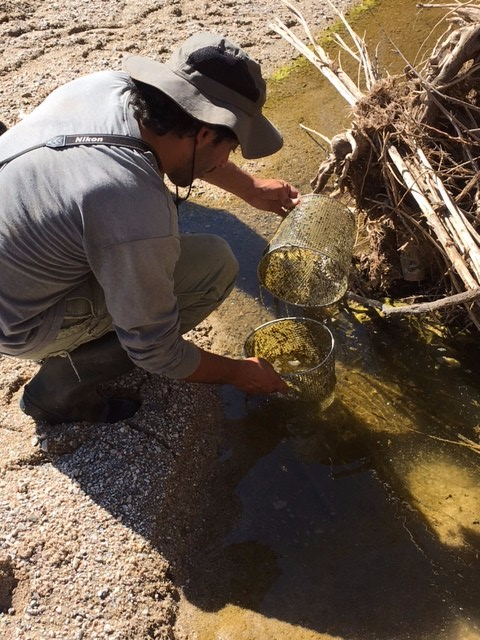Two desert parks devoted to protection and conservation, Organ Pipe Cactus National Monument and El Pinacate y Gran Desierto del Altar, are split by the international United States and Mexico boundary. The two parks run parallel along Federal Highway 2- the fronterra. Protected and respected on both sides, the two sister parks are seemingly back to back, facing their countries. However, it’s a mistake to assume they’re not communicating. The parks aren’t back-to-back; rather, they are facing each other, ready to shake hands in collaboration.
The “Three Parks: One Partnership” NPS grant-funded project includes Arizona-Sonora Desert Museum, Organ Pipe Cactus National Monument and El Pinacate y Gran Desierto del Altar. The three organizations are aligned in a mission to help protect the desert pupfish (cachorrito o pupo del desierto), longfin dace (charalito aleta larga) and Sonoyta mud turtle (tortuga de agua de Sonoyta).
While the international collaboration isn’t exactly new, the revitalization is. In a time when financial pressures and political repercussions are hitting both sides of the border, the project remains intact and friendships remain fierce. Unbeknownst to the world, a small group of people have made a difference in the success of three endangered species. Nature and conservation indeed have no borders.

The Work Continues: Monitoring
Monitoring for pupfish, mud turtles and invasive species was conducted in Rio Sonoyta by a small team of fish experts, biologists and educators. The search was on for mud turtles. Once one was found (which was no easy feat as these reptiles have impeccable camouflage and tend to bury themselves), their vitals were taken: length, width, weight, curve of carapace and sex. We weren’t after their Body Mass Index; rather, more interested in a comprehensive look at the animal. The rulers, scales and calipers equipped the team to measure everything but their IQ.
Then, each turtle had a turn with the biological paparazzi. Individuals had their carapace and plastron snapped next to their stats. It will be invaluable information continuing forward as the population grows.

Pupfish were observed zigging and zagging, their schools herded by dominant males underfoot. Their capacity to survive astounds. Even when the river is dry, muddy, and near desiccation the pupfish can swim in a few millimeters of water by flattening out. They’ve rightfully earned to the moniker ‘bulldogs’ due to their resilience and population’s ability to fight back. Fish traps were set using crackers as bait and although many schools were observed, only 26 individuals for the day were counted (3 males, 23 females).

Facility Recommendations
Longfin dace aren’t showy or sexy. They don’t flash blue like a male pupfish or have the pleading emotional eyes of vaquitas. So, they’re a hard sell for the general public and conservationists alike. With fewer than 100 individuals left, a small group of dedicated ichthyologists (fish geeks) are doing everything in their power to help save the species and establish populations at several refugium sites spread between Sonoyta, Quitovac, Puerto Peñasco and Tucson.
The Fish Team visited five locations to give feedback and collaborate on enhancements to the project. Anyone with a backyard pond or pool knows that bodies of water are finicky things and some demand more attention than others. One site might need more sunlight, another less. One has too many plants, another too few. So comparing each site and giving recommendations for further work was important. Going forward each site will have regular water quality tests conducted to measure pH, salinity, temperature, oxygen and carbon dioxide levels.


Education
Near the Quitovac oasis sits a small boarding school for kids of the area and Sonoyta. The team spent a morning with approximately 30 elementary students playing Lotería del Desierto, cleaning the oasis, and setting fish traps to explain and emulate the importance of caring for their natural world. Throughout the day the biologists and educators taught natural history of desert plants and animals while the children taught the adults regional names for their flora and fauna. Often overheard was “¡Sí, bueno!” by an American when a student made a connection or pointed out an animal. Some educators were learning Spanish, and had the opportunity to increase their vocabulary. But responding quickly to an interested child often yielded frustrating results for communicative purposes. Thus, “¡Sí, bueno!” became a running and humorous theme for the day.


After visiting Organ Pipe Cactus National Monument, the community of Quitovac, and Pinacate Biosphere Reserve, educators from each institution discussed what information from the “3 Parks: 1 Partnership” project that would be useful to interpret with their audiences. Consequently, the Arizona-Sonora Desert Museum will be producing a comprehensive trilingual field guide about the project that each park can utilize. Desert pupfish, longfin dace, and Sonoyta mud turtle, along with conservation messaging will be highlighted.
Next Steps
The key to the success of three cold blooded creatures might come down to the work of just a few dedicated mammals. Chuck Minckley, now retired, spent his life working on desert fishes. At each stop he gave pointers to biologist Mike Grageda who’s in his second year with the Pinacate Biosphere Reserve. Listening and absorbing the conversation was Diego Garcia, who’s experiencing what it’s like to be in the field as it was his first day on the job. Passion for conservation flows freely through two languages and across borders. One man seemed to be handing the reigns to another. Will the fish and turtles have a fighting chance? With time, support, and continued collaboration, our response is an emphatic “¡Sí, bueno”!
Written by: Catherine Bartlett, ASDM Education Specialist






2 Comments Add yours